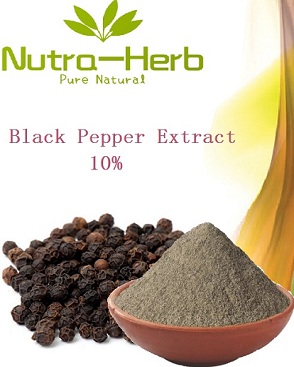- Plant-Based Protein
- Natural Plant Flavours
- Food and Dietary Supplement Ingredients
- Fruit Juice Powder
- Animal Nutrition Ingredients
- Water Soluble Ingredients
- Cosmetic Ingredients
- Unveiling the Therapeutic Potential of Rabdosia Rubescens: A Comprehensive Review
- What are the medicinal properties of Rabdosia Rubescens?
- Nutritional value of Orange Juice Powder compared to fresh orange juice.
- Processing Conditions and Nutritional Value of Orange Juice Powder
- Exploring the Versatility of Herbal Extracts in Food Flavors
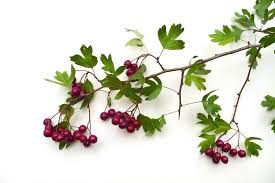
What are the health benefits of hawthorn leaf?
Welcome to our blog! Today, we are diving into the world of hawthorn leaf and uncovering its incredible health benefits. Whether you're a fan of herbal remedies or simply curious about natural alternatives, hawthorn leaf is definitely worth exploring.


Medicinal herb-Uncaria tomentosa,Antibacterial, Anticoccidiosis,Immune stimulator
Uncaria tomentosa (Cat's claw) is used commercially as a medicinal herb primarily for immune system stimulation. Cat’s claw is also effective as antioxidant, Antiprotozoal, antimicrobial, and anti-inflammatory. Uncaria tomentosa is a potent complimentary herb for treating most parasites. Which is effective to treat coccidisosis in poultry and livestock flock.
Background
The withdrawal of antibiotic growth promoters from the list of allowed feed additives forced livestock producers to look for legal and safe substitutes. These included probiotics, synbiotics, enzymes and proenzymes, minerals, organic and inorganic acids, as well as phytobiotics, i.e. plant extracts and substances dervied from herbs.Medicinal plants contain a range of biologically active compounds in various combinations, thus they may have a varied effect on the animal body.The interest in phytobiotics as a natural food component will continue to grow, along with the consumers’ awareness and the growing demand for healthy food products.
Uncaria tomentosa (Cat's claw) is a kind of medicinal plants used in the feeding of livestock animals, such as cattle, poultry and swine. It is used commercially as a medicinal herb primarily for immune system stimulation. Cat’s claw is also effective as antioxidant, antimicrobial, and anti-inflammatory. Uncaria tomentosa is a potent complimentary herb for treating most parasites. Which is effective to treat coccidisosis in poultry and livestockResearch has confirmed the effectiveness of Uncaria tomentosa (Cat's claw) as natural growth promoters and proved they represent an alternative for banned antibiotics.
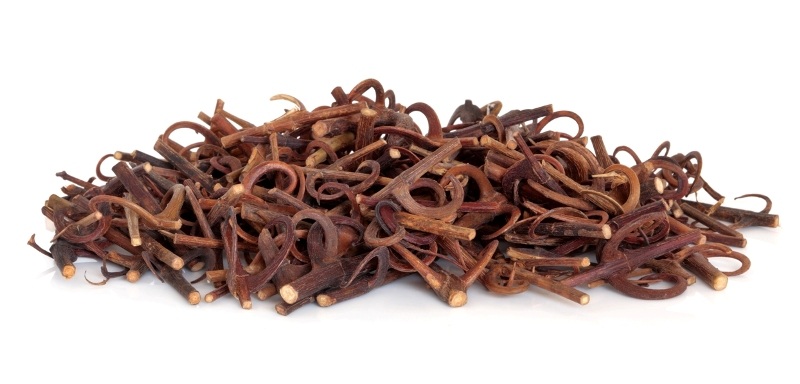
What you may get from us: If you're developing a feed additive that contains medicinal herb of Uncaria Species (Cat's claw).I think you can find the information or products you need here.
Simple production process in our factory: After the plant is collected, It can be made straight powder. Or the raw material will be processed by solvent extraction, separation and purification, filtration, concentration, drying and other steps to form the final products. We may also design a prouction process based on your special requirements.
Through the physical and chemical processes, those compunds you don't want was removed, and the compunds preferred was accumulated. Which make the products achieve the best effects.
|
Cat's claw Straight powder or Cat's claw Extract |
||
|
Appearance |
Powder |
|
|
Color |
Brown |
|
|
Partical size |
Normally pass through 60mesh |
|
|
Pack size |
25 kg per paper drum |
|
|
Purity of active compunds |
3%Alkaloids |
By UV |
|
For pricing or more information, please call 86 29 88444632 or send an email to Sales@nutraherbsource.com.
|
||
General Information
Species:
Uncaria guianensis (Aublet) Gmeliu
Synonym: Ourouparia guianensis (Aublet)
Uncaria tomentosa (Willdenow ex Roemer & Shultes) D.C.
Synonym: Nauclea oculeata H.B.K.; Nauclea tomentosa Willdenow ex Roemer & Shultes; Ourouparia tomentosa (Willdenow ex Roemer & Shultes) Shumann
Common Name: Cat's claw, Gouteng, gutan.
Family: Rubiaceae
Plant information
Uncaria tomentosa
A large woody vine or creeping shrub, typical of primary forest, but also found in disturbed forest and rarely in secondary forest. The external bark has superficial longitudinal fissures, and the internal bark is fibrous, with the ground bark the color golden yellow. The sap is watery and astringent in taste. The terminal branchlets are quadrangular and yellow-green in color. The leaves are simple, opposite and distinct; oblong, oblong-ovate, or elliptic; 7.5–17 cm in length and 5–12 cm in width. The leaf margins are entire; apex is acute, or rarely acumate; base is round and/or cordate. The stipules are deltoid, 6–12 mm long and 4–8 mm wide. The spines are woody, occur in pairs, are slightly curved but straight, and pointy; 8–10 mm in length and 3–6 mm in width. The inflorescences occur in racemes or globular cymes, are axilarary and/or terminal, 7–18 cm in length, 1.5–2.5 cm in diameter. Flowers are bisexual, actinomorphic and sessil. The calyx is gamosepalous, tubular, 1–1.5 mm in length and 0.8–1 mm in diameter. The corolla is gamopetalous, 7–13 mm in length, 3–5 mm in diameter, with 5 round lobes; yellow. Stamens are sessil; 5-fused to the throat. The anthers are oblong with prolonged and divergent bases; 1–1.2 mm in length and 0.3–0.4 mm in width. The stigma is ellipsoid, 0.5 mm in length, with linear 4 mm long styles; inferior ovary. The fruits are dry and dehiscent; elliptic capsules; 5–8 mm long and 3–6 mm wide.
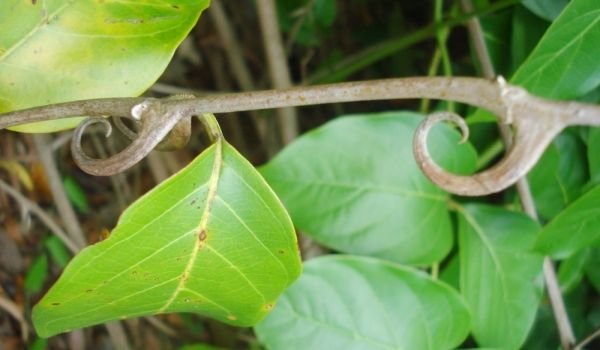
Uncaria guianensis
A woody perennial vine or creeping shrub found mostly in secondary forest. External bark with superficial fissures; internal bark is fibrous and golden brown. The sap is watery with an astringent taste. Terminal branches are quadrangular, with a pale rosy green color; glabrous. Leaves are simple, opposite and distinct, elliptic to elliptic-oblong in shape; 7.8–18.5 cm in length, 4.6–9.5 cm in width. Leaf margins are entire with an acute apex, and an acute to acute-round base. Stipules are lanceolate shaped and 8–14 mm long and 3–5 mm wide. Spines are woody and strongly curved in the form of a hook, 4–26 mm long and 2–5 mm wide. Inflorescences are arranged in racemes or apexes of spherical umbels; terminal or axillary; 10–20 cm in length (inflorescences) and 1.5–4 cm in diameter (umbel), with glabrous peduncles. Flowers are bisexual and actinomorphic on 4 mm long pedicels. Calyx with jointed sepals, tubular to bell-shaped, 5–10 mm long and 3-5 mm in diameter. Corolla has jointed petals; 7–13 mm long and 3–5 mm in diameter; red-orange with a smooth interior and an exterior that is smooth on the bottom, with the top 1/3 with villous hairs. Adroecium has 5 subsessile stamens, adnate to the throat of the corolla. The pistil has an ellipsoid stigma, 1.5 mm. in length; inferior ovary. The fruits are dry and dehiscent, elliptical capsules; 10–12 mm long and 4–6 mm wide with numerous seeds, 6-8 mm long and 0.8-1.4 mm wide.
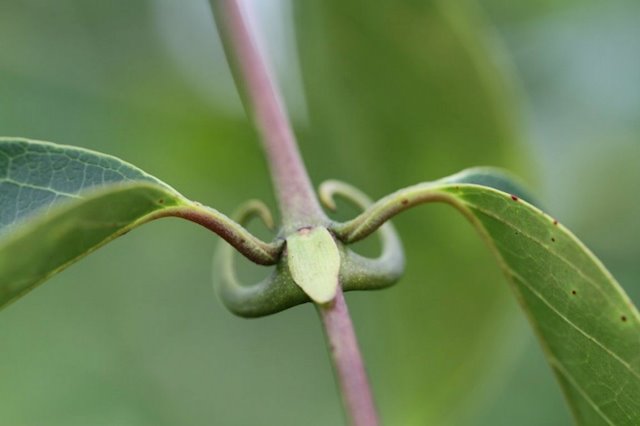
Chemical Constituents of Uncaria tomentosa
Studies reported the chemical constituents of several Uncaria species and recognized the different molecules present in different parts of the plant. It is worth noting that more than 50 phytochemical molecules have been identified and isolated from U. tomentosa, some of them are considered new to that species. Uncaria tomentosa leaves contain higher oxindole alkaloid content than that present in stem bark and branches. There are speciophylline and uncarine F (the main oxindole alkaloids) in leaves that can occur as tetracyclic oxindole alkaloid (TOA) or pentacyclic oxindole alkaloid (POA) derivatives. Both TOA and POA are liable to isomerization that depends mainly on medium polarity, pH, and temperature. Cat’s claw contains several active compositions including ajmalicine, campesterol, carboxyl alkyl esters, akuammigine, sitosterols, rutin, chlorogenic acid, speciophylline, catechin, cinchonain, corynoxeine, harman, daucosterol, epicatechin, hirsuteine, corynantheine, hirsutine, loganic acid, mitraphylline, iso-pteropodine, oleanolic acid, ursolic acid, lyaloside, rhynchophylline, palmitoleic acid, pteropodine quinovic acid glycosides, procyanidins, stigmasterol, 3,4-dehydro-5- carboxystrictosidine, vaccenic acid, uncarine A thru F, and strictosidines. Moreover, other reports revealed that various compounds other than oxindole alkaloids such as rotundifoline and isorotundifolune, coumarins, flavonoids, quinovic acid glycosides, and triterpenes may be responsible for the cat’s claw medicinal effects.
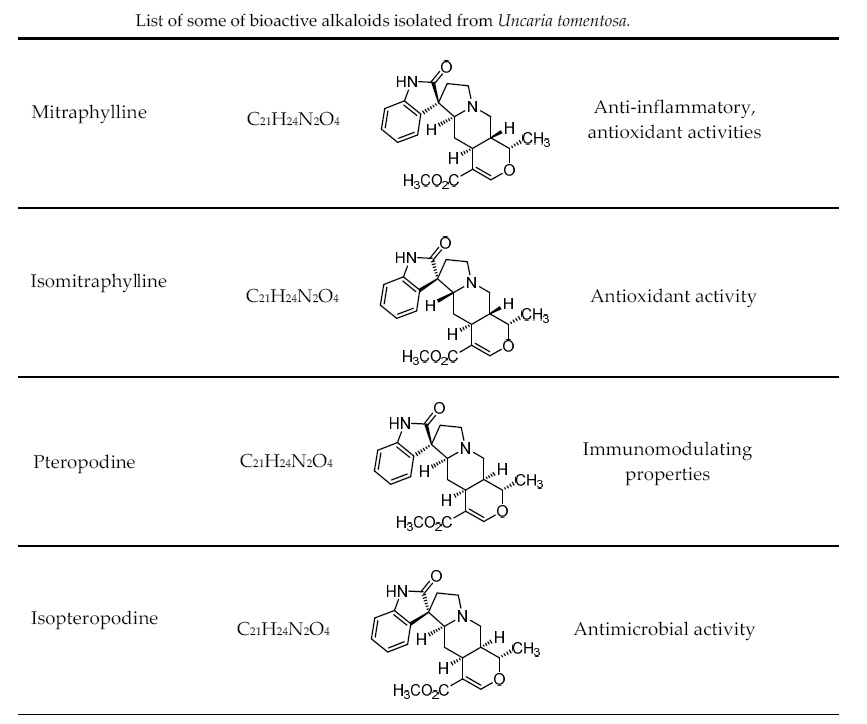
Traditional Uses
Uncaria tomentosa bark and root have been traditionally used as a therapy in tropical South America for many conditions, like inflammations, cancer, gastric ulcers, arthritis, and infections. Moreover, it was documented to be used for blood purifications, after child delivery as a wash for wounds to allow skin healing, cleansing the kidneys, asthma, inhibition of several diseases, menstrual irregularity and hemorrhages, fevers, and possess a normalizing activity on body systems. It also was used for the treatment of various ailments including abscesses, urinary tract infections, contraception, rheumatism, and weakness. Additionally, it was used as a treatment option for mental disorders (e.g., anxiety). Some indigenous people in America used the water stored in the stem to quench thirst, and as a restorative drink.
The health effect of Cat's claw in poultry and livestock Flock
Immunoregulatory Effect of Uncaria tomentosa bark extracts (cat's claw extract)
The increased production of IL-1, IL-6, and IFN-γ suggesting that immunoregulatory effect was reported in aqueous extracts and a mixture of oxindole alkaloids. The extracts displayed enhanced lymphocyte activity owing to adjuvant immune activity observed by the pneumococcal vaccine: neutrophil ratio and persistent antibody titer responses towards 12 pneumococcal serotypes. These plant extracts were tested in vitro, in vivo, and in gene expression studies displayed similar anti-inflammatory activities, such as the inhibition of the activation of NF-κB and suppresses TNF-α synthesis. The reduced production of TNF-α and scavenging of free radicals explained the cytoprotective function of Cat’s claw. The aqueous extract of this plant was indicated in rheumatoid arthritis treatment. The extracts could protect from lethal infections of Listeria monocytogenes and could significantly increase granulocyte-macrophage progenitor cells in bone marrow. A 2% gel of Cat’s claw demonstrated antibacterial properties against Enterococcus faecalis in an in vitro study. The plant extracts demonstrated both antiviral and cytokine modulation in human monocytes infected with dengue virus. Cat’s claw is useful for improving the symptoms of Alzheimer’s disease by its antioxidant effects and also by peripheral blood vessel dilation in the brain by rynchophylline alkaloids. It was reported that the immune-stimulating alkaloids pteropodine and isopteropodine have positive modulatory effects on brain neurotransmitters (5-hydroxy tryptamine) receptors; these are important drug targets in treating a range of ailments such as depression, anxiety, and obesity.
Uncaria tomentosa contains pentacyclic as well as tetracyclic alkaloids, in particular of indole and oxindole, which impart two different chemotypes. As both types of alkaloids impart an antagonistic effect on each other, the medicinal application of these two alkaloid mixtures (pentacyclic and tetracyclic) has been reported as unsuitable. The standardized preparation of Uncaria with a high proportion of pentacyclic alkaloids is recommended and used for therapeutic purposes. Commercially available preparations, including a decoction, fluid extract, or capsules, are commonly used.
The Anti-inflammatory activity of Uncaria tomentosa bark extracts (cat's claw extract)
A 80% of ethanolic spray dried extract, containing 5.61% of total oxindole alkaloids and aqueous freezedried Uncaria tomentosa extract (total oxindole alkaloids 0.26%) were assessed and compared in carrageenan- induced paw edema model in BALB/c mice. The extracts dose-dependently and significantly decreased the carrageenan-induced increase in paw volume as compared with control rats. The two extracts were diluted in 1 ml distilled water in concentrations 500, 200, 100 and 50 mg/kg and were administered through a gastric probe during 8 days of pre-treatment. The paw inflammation was measured 4 hours after the carrageenan injection. The negative control group received distilled water, the positive control group indomethacin (7 mg/kg). Hydroalcoholic extract (50 mg/kg) produced an anti-inflammatory effect similar to 7 mg/kg of the non-steroidal drug indomethacin, while the aqueous freeze-dried extract exhibited the same effect at 200 mg/kg.
The anti-inflammatory effects of oral treatment for 3 days with micropulverized Uncaria tomentosa bark (cat's claw extract), 5 mg/ml, given in drinking water prior to the oral administration of indomethacin, protected against indomethacin-induced gastritis (20 mg/kg body wt) in Sprague-Dawley rats (number not given). Cat's claw extract elicited a protective effect (p<0.01), the degree of gastric mucosal injury was markedly attenuated and prevented TNF-α mRNA expression and apoptosis.
Antibacterial and Antifungal properties
Although Uncaria tomentosa is not used extensively to treat infections in traditional medicine, recently some in vitro reports evaluating antibacterial and antifungal activities were published. Both extracts of the bark (80% ethanolic, aqueous, methanolic, dichlormethanic) and compounds (isopteropodine, arthocamin A, 5’-hydroxycudraflavone A, dihydrocudraflavone B) were tested, and in the case of some bacterial (B. cereus, B. subtilis, Enterococcus faecalis, Staph. aureus, Staph. epidermidis, E. coli, M. flavus, Strep. Mutans, Klebsiella pneumoniae) and fungal strains (effective against Candida albicans in one out of three study) oderate effects was observed.
Antiviral effect
The data on the antiviral effects of Uncaria tomentosa is very limited. In two in vitro studies, the hydroalcoholic extracts of the stem bark exhibited antiherpetic activity (Herpes simplex virus type 1, HSV-1), by inhibiting the attachment of HSV-1; and significantly decreased Dengue virus-2-Ag in monocytes as well. Interestingly, the oxindole alkaloid purified fraction and quinovic acid glycosides purified fraction did not present activity against HSV1, yet the alkaloidal fraction was more effective than the extract in the case of DENV infection. Moreover the antiviral activity against Vesicular stomatitis virus was evident for six quinovic acid glycosides, isolated from Uncaria tomentosa.
Antiprotozoal and Anticoccidial activity
The previous study documented the antimicrobial effect of Uncaria tomentosa bark extracts against several morphological forms of Borrelia burgdorferi and respiratory pathogens namely Enterococcus faecalis, Pseudomonas aeruginosa and Staphylococcus aureus and this activity were attributed to the presence of proanthocyanidins, including dimers and oligomers up to undecamers. Uncaria tomentosa showed remarkable antifungal efficacy against various anidulafungin, terbinafine and fluconazoleresistant non-albicans species. The antiprotozoal activity has been recently documented by Batiha et al. against Babesia and Theileria parasites and this efficacy was attributed to its ability to digest harmful microorganisms. In addition to that, it has been documented to treat many parasites except Giardia. Therefore, Uncaria tomentosa could be a good complementary antiprotozoal herb. The antiviral activity of quinovic acid glycosides has been demonstrated in vitro against vesicular stomatitis, ribonucleic acid (RNA), a minus-strand RNA virus, and rhinovirus 1B. Caon et al. assessed the in vitro antiherpetic activity of hydroethanolic Uncaria tomentosa extract, as well as the purified fractions of oxindole alkaloids and quinovic acid glycosides against herpes simplex virus (HSV) infections as well as the protective activity of these preparations on UV-induced DNA damage.
It has been reported that Uncaria extract can prevent and cure coccidiosis in birds and rabbits. The coccidiosis index of Uncaria preparation and diclazuril control group can reach the same level.
Dosage:
Natural compounds such ans plant extracts are used or evaluated as diet supplements to a alleviate the negative effects of coccidiosis. Anticoccidial outcomes are often indirectly assessed by survival rates, improved growth performance, feed conversion, intestinal lesions,and bloddy diarrhea.Tirals showed that Uncaria tomentosa extract,20mg/kg feed, significantly increased body weight gains and reduced bloody diarrhea,lesion score, and oocyst excretion.
- Prev:Medicinal herb Pulsatilla,Antibacterial,Anticoccidiosis,Anti diarrhea,Immune stimulator
- Next:Medicinal herb, Dichroa febrifuga, Anticoccidiosis, Antimalarial, Use for poultry



